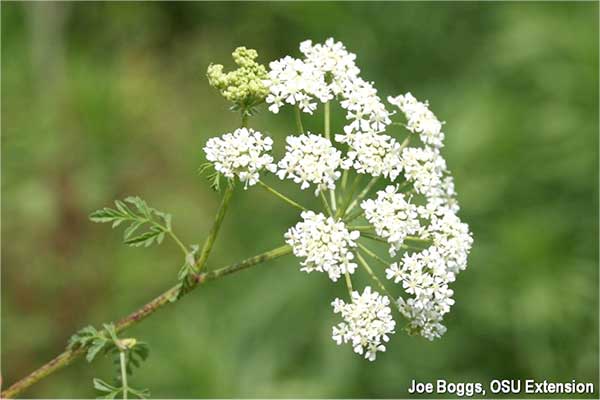|
|
 |
|
Poison Hemlock all
Around the County
Sam Custer
OSU Extension, Darke County
Poison hemlock (Conium maculatum) is among the most deadly plants in
North America and we have it all around the county. It is
especially prevalent in fencerows, edges of fields, railroad beds, and
pastures. This non-native invasive weed contains highly toxic
piperidine alkaloid compounds, including coniine and gamma-coniceine,
which cause respiratory failure and death when ingested by
mammals. The roots are more toxic than the leaves and stems;
however, all parts of the plant including the seeds should be
considered dangerous. It is a common misconception that poison
hemlock sap will cause skin rashes and blisters. In fact, poison
hemlock toxins must be ingested or enter through the eyes, cuts, or
other openings to cause poisoning.
Poison hemlock is a biennial weed. It spends the first year as a
basal rosette and the second year as an erect, towering flowering plant
that can measure 6-10' tall. Despite its common name, poison
hemlock is not a tree; it is a member of the carrot family, Apiaceae
(formerly Umbelliferae). Thus, it shares many characteristics
with other members of the carrot family found growing in Ohio including
native plants such as QUEEN ANNE'S LACE (Daucus carota) and other
non-natives such as WILD PARSNIP (Pastinaca sativa).
Wild parsnip is notorious for containing sap loaded with
furanocoumarins that produce a light-linked condition called
phytophotodermatitis in humans and livestock. If plant juices
contact skin and the skin is then exposed to sunlight (specifically
ultraviolet light), severe blistering can occur, as well as skin
discoloration that may last several months.
All stages of the poison hemlock plant have bluish-green leaves that
are 3-4 times pinnately compound, and the deeply cut parsley-like
leaflets have sharp points. Flowering plants have hairless,
light-green to bluish-green stems that are covered with obvious
purplish blotches. Clusters of tiny white flowers are borne on
structures called umbels that look like upside-down umbrellas.
While poison hemlock can be partially managed by mowing and tilling,
the most effective control approach involves properly timed
applications of selective or non-selective post-emergent herbicides
including glyphosate (e.g. Roundup). It is a prolific seed
producer, so applications of herbicides made now will control both the
first season rosette stage and the second season flowering stage,
before seeds are produced.
For more information about OSU Extension, Darke County, visit the Darke
County OSU Extension web site at www.darke.osu.edu, the OSU Extension
Darke County Facebook page or contact Sam Custer, at 937.548.5215.
|

|
|
|
|

